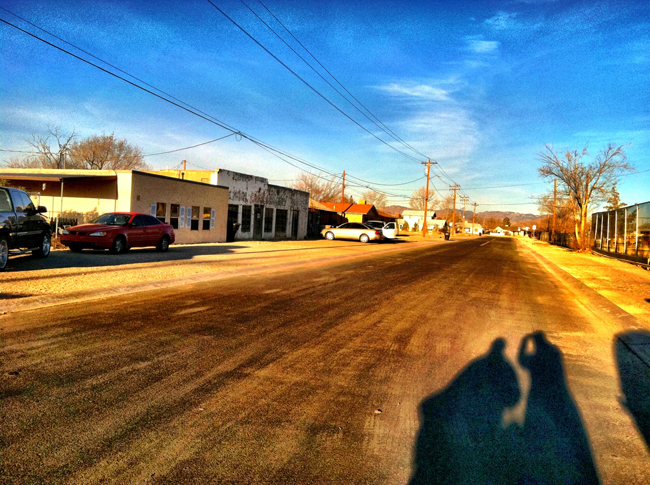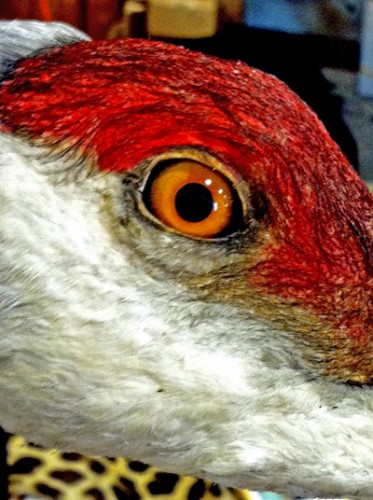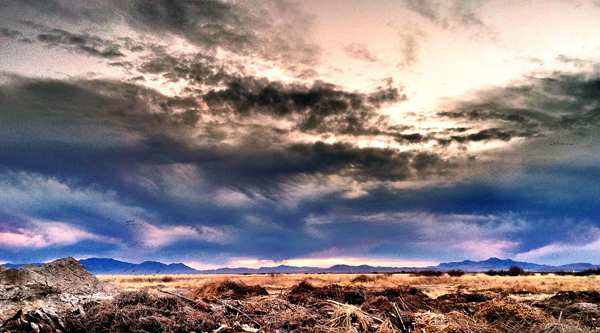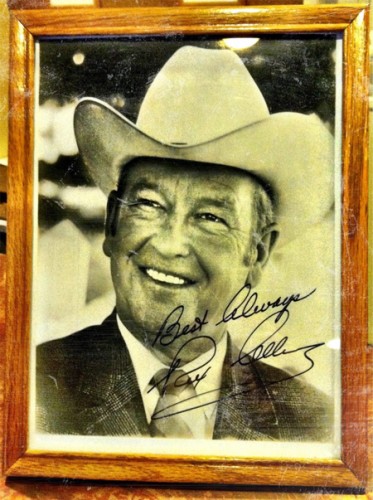Willcox at eye level
Like the Sandhill cranes, I usually visit Willcox in the winter. That’s when the town hosts Wings Over Willcox, a birding and cultural event celebrating the cold season presence of Sandhill cranes, who dwell in the fields and wetlands of the Sulphur Springs Valley from October to March. (below, Stewart St. in Willcox AZ. Photo A. Shock)
In winter when the trees are bare and the lawns are brown, the city of Willcox Arizona looks very close to the earth: the houses and buildings in the older neighborhoods seem to  sit right on the dirt, as if they’d pushed up through the soil like sensible angular mushrooms after a rain. It’s a down-to-earth kind of place, surrounded by ranches and farms, and snow-dusted peaks.
sit right on the dirt, as if they’d pushed up through the soil like sensible angular mushrooms after a rain. It’s a down-to-earth kind of place, surrounded by ranches and farms, and snow-dusted peaks.
<< Sandhill crane eye, mounted specimen. Very dinosaur-y, isn’t it? When I see this eye, I’m glad I’m not a seed.
Except for the newer part of town, which is latched onto Interstate 10’s throat like a tick, the town has pretty much one of everything — just what folks who live here need, but no more: a couple of gas stations, a mechanic or two, a winery, a golf course, a handful of restaurants that may or may not be under the same ownership each time I return, or even open at all; schools, fire department, churches. But down-to-earth Willcox also has a big sky feel. This time of year that sky infuses the fields and grasslands with earnest birds, gleaning seeds from grassheads, foraging the  fields for leftover crop — not only large cranes, but also lark bunting, meadowlarks, vesper, savannah, song, white-crowned and lark sparrows. Raptors and shrikes follow the birds: the kestrels, merlins, and accipiters sharp-eyeing the sparrows, the larger hawks stalking rodents above ground during the sunny days; owls take over the hunt in the waxing moon nights. Ravens hang in high places cawing, opportunistically looking for a tidbit or some fun anywhere. Birders and tourists flock here as well, to the festival and on their own, following all of it: cranes, owls, raptors, sparrows, and scope-toting tour leaders with fieldguides tucked into their khaki vests. (Photo above: twilight over the Sulphur Springs Valley outside of Willcox. There are thousands of invisible cranes in this picture, standing in the yellow grasses in the mid-distance. The black dots in the air low on the left edge of the image are cranes coming in to join them to roost for the night. Photo A.Shock)
fields for leftover crop — not only large cranes, but also lark bunting, meadowlarks, vesper, savannah, song, white-crowned and lark sparrows. Raptors and shrikes follow the birds: the kestrels, merlins, and accipiters sharp-eyeing the sparrows, the larger hawks stalking rodents above ground during the sunny days; owls take over the hunt in the waxing moon nights. Ravens hang in high places cawing, opportunistically looking for a tidbit or some fun anywhere. Birders and tourists flock here as well, to the festival and on their own, following all of it: cranes, owls, raptors, sparrows, and scope-toting tour leaders with fieldguides tucked into their khaki vests. (Photo above: twilight over the Sulphur Springs Valley outside of Willcox. There are thousands of invisible cranes in this picture, standing in the yellow grasses in the mid-distance. The black dots in the air low on the left edge of the image are cranes coming in to join them to roost for the night. Photo A.Shock)
All of this activity is watched over by Willcox’s long history. Once known as the cattle capital of the  U.S., ranching and agriculture are still big here, although Interstate 10 has replaced the railroad as the town’s main lifeline. But freight still rumbles through town, rolling between southern California and Texas railyards: the noisy calling of cranes in the fields is often momentarily drowned out by train horns, a more soulful, lonely sound than the busy clacking of the social birds.
U.S., ranching and agriculture are still big here, although Interstate 10 has replaced the railroad as the town’s main lifeline. But freight still rumbles through town, rolling between southern California and Texas railyards: the noisy calling of cranes in the fields is often momentarily drowned out by train horns, a more soulful, lonely sound than the busy clacking of the social birds.
>> Rex Allen also watches over Willcox. The Willcox native, known as the “Arizona cowboy”, was a Western singer and actor known for his folksy film narration. His autographed images hang on the walls of just about every joint in town, from Tex’s BBQ Dining Car to the chain hotel lobbies.

Allison, I enjoyed your narrative of your time in Wilcox. The line “latched onto Interstate 10’s throat like a tick” is perfect.
I love Rex Allen…ah, what a voice!